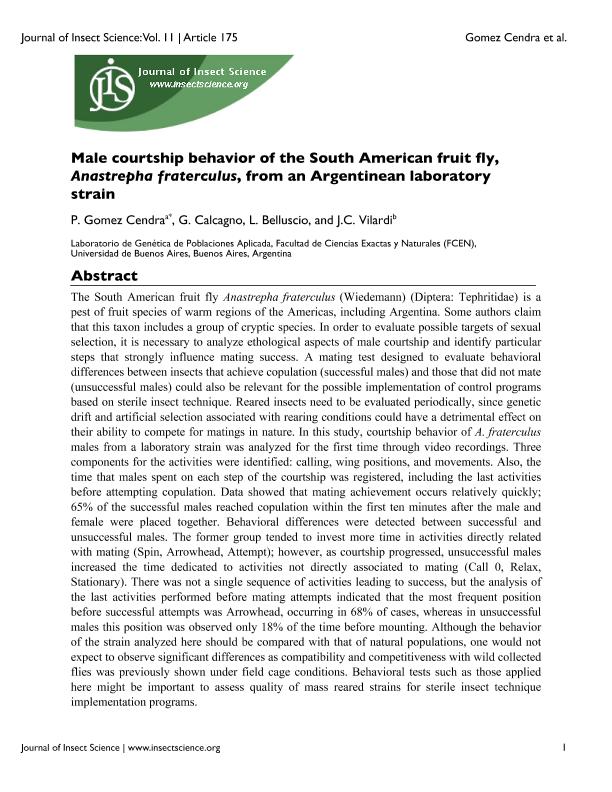Artículo
Male courtship behavior of the south american fruit fly, anastrepha fraterculus, from an Argentinean laboratory strain
Fecha de publicación:
12/2011
Editorial:
University of Arizona
Revista:
Journal of Insect Science
ISSN:
1536-2442
Idioma:
Inglés
Tipo de recurso:
Artículo publicado
Clasificación temática:
Resumen
The South American fruit fly Anastrepha fraterculus (Wiedemann) (Diptera: Tephritidae) is a pest of fruit species of warm regions of the Americas, including Argentina. Some authors claim that this taxon includes a group of cryptic species. In order to evaluate possible targets of sexual selection, it is necessary to analyze ethological aspects of male courtship and identify particular steps that strongly influence mating success. A mating test designed to evaluate behavioral differences between insects that achieve copulation (successful males) and those that did not mate (unsuccessful males) could also be relevant for the possible implementation of control programs based on sterile insect technique. Reared insects need to be evaluated periodically, since genetic drift and artificial selection associated with rearing conditions could have a detrimental effect on their ability to compete for matings in nature. In this study, courtship behavior of A. fraterculus males from a laboratory strain was analyzed for the first time through video recordings. Three components for the activities were identified: calling, wing positions, and movements. Also, the time that males spent on each step of the courtship was registered, including the last activities before attempting copulation. Data showed that mating achievement occurs relatively quickly; 65% of the successful males reached copulation within the first ten minutes after the male and female were placed together. Behavioral differences were detected between successful and unsuccessful males. The former group tended to invest more time in activities directly related with mating (Spin, Arrowhead, Attempt); however, as courtship progressed, unsuccessful males increased the time dedicated to activities not directly associated to mating (Call 0, Relax,Stationary). There was not a single sequence of activities leading to success, but the analysis of the last activities performed before mating attempts indicated that the most frequent position before successful attempts was Arrowhead, occurring in 68% of cases, whereas in unsuccessful males this position was observed only 18% of the time before mounting. Although the behavior of the strain analyzed here should be compared with that of natural populations, one would not expect to observe significant differences as compatibility and competitiveness with wild collected flies was previously shown under field cage conditions. Behavioral tests such as those applied here might be important to assess quality of mass reared strains for sterile insect technique implementation programs.
Palabras clave:
Mating
,
Sterile Insect Technique
,
Tephritids
Archivos asociados
Licencia
Identificadores
Colecciones
Articulos(IEGEBA)
Articulos de INSTITUTO DE ECOLOGIA, GENETICA Y EVOLUCION DE BS. AS
Articulos de INSTITUTO DE ECOLOGIA, GENETICA Y EVOLUCION DE BS. AS
Citación
Gómez Cendra, Paula Valeria; Calcagno, G.; Belluscio, Laura María; Vilardi, Juan Cesar; Male courtship behavior of the south american fruit fly, anastrepha fraterculus, from an Argentinean laboratory strain; University of Arizona; Journal of Insect Science; 11; 1; 12-2011; 1-18
Compartir
Altmétricas




